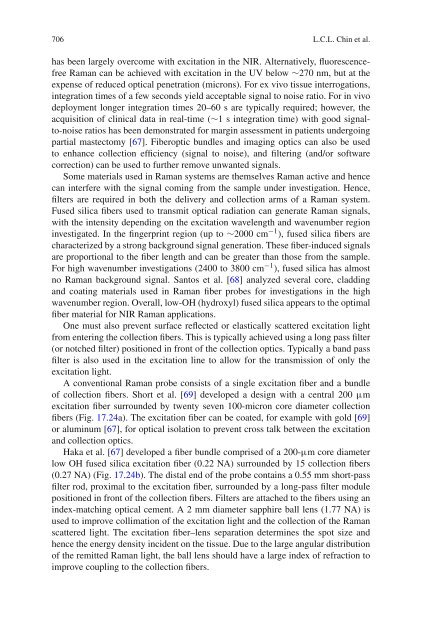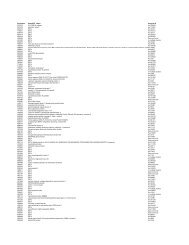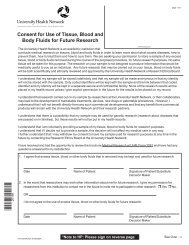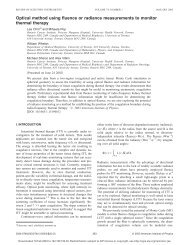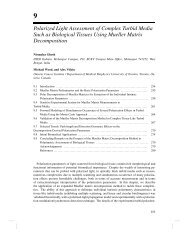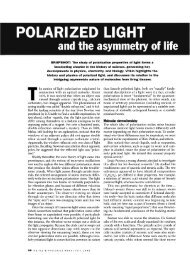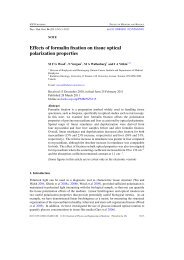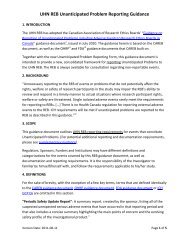Optical Fiber Sensors for Biomedical Applications
Optical Fiber Sensors for Biomedical Applications
Optical Fiber Sensors for Biomedical Applications
You also want an ePaper? Increase the reach of your titles
YUMPU automatically turns print PDFs into web optimized ePapers that Google loves.
706 L.C.L. Chin et al.has been largely overcome with excitation in the NIR. Alternatively, fluorescencefreeRaman can be achieved with excitation in the UV below ∼270 nm, but at theexpense of reduced optical penetration (microns). For ex vivo tissue interrogations,integration times of a few seconds yield acceptable signal to noise ratio. For in vivodeployment longer integration times 20–60 s are typically required; however, theacquisition of clinical data in real-time (∼1 s integration time) with good signalto-noiseratios has been demonstrated <strong>for</strong> margin assessment in patients undergoingpartial mastectomy [67]. <strong>Fiber</strong>optic bundles and imaging optics can also be usedto enhance collection efficiency (signal to noise), and filtering (and/or softwarecorrection) can be used to further remove unwanted signals.Some materials used in Raman systems are themselves Raman active and hencecan interfere with the signal coming from the sample under investigation. Hence,filters are required in both the delivery and collection arms of a Raman system.Fused silica fibers used to transmit optical radiation can generate Raman signals,with the intensity depending on the excitation wavelength and wavenumber regioninvestigated. In the fingerprint region (up to ∼2000 cm −1 ), fused silica fibers arecharacterized by a strong background signal generation. These fiber-induced signalsare proportional to the fiber length and can be greater than those from the sample.For high wavenumber investigations (2400 to 3800 cm −1 ), fused silica has almostno Raman background signal. Santos et al. [68] analyzed several core, claddingand coating materials used in Raman fiber probes <strong>for</strong> investigations in the highwavenumber region. Overall, low-OH (hydroxyl) fused silica appears to the optimalfiber material <strong>for</strong> NIR Raman applications.One must also prevent surface reflected or elastically scattered excitation lightfrom entering the collection fibers. This is typically achieved using a long pass filter(or notched filter) positioned in front of the collection optics. Typically a band passfilter is also used in the excitation line to allow <strong>for</strong> the transmission of only theexcitation light.A conventional Raman probe consists of a single excitation fiber and a bundleof collection fibers. Short et al. [69] developed a design with a central 200 μmexcitation fiber surrounded by twenty seven 100-micron core diameter collectionfibers (Fig. 17.24a). The excitation fiber can be coated, <strong>for</strong> example with gold [69]or aluminum [67], <strong>for</strong> optical isolation to prevent cross talk between the excitationand collection optics.Haka et al. [67] developed a fiber bundle comprised of a 200-μm core diameterlow OH fused silica excitation fiber (0.22 NA) surrounded by 15 collection fibers(0.27 NA) (Fig. 17.24b). The distal end of the probe contains a 0.55 mm short-passfilter rod, proximal to the excitation fiber, surrounded by a long-pass filter modulepositioned in front of the collection fibers. Filters are attached to the fibers using anindex-matching optical cement. A 2 mm diameter sapphire ball lens (1.77 NA) isused to improve collimation of the excitation light and the collection of the Ramanscattered light. The excitation fiber–lens separation determines the spot size andhence the energy density incident on the tissue. Due to the large angular distributionof the remitted Raman light, the ball lens should have a large index of refraction toimprove coupling to the collection fibers.


